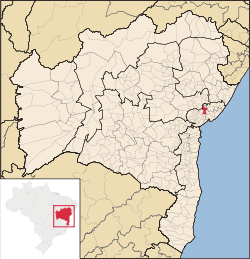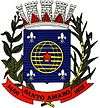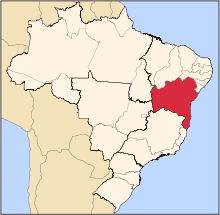Santo Amaro, Bahia
| Santo Amaro | |||
|---|---|---|---|
| Municipality | |||
| |||
 Location in Bahia state | |||
 Santo Amaro Location in Brazil | |||
| Coordinates: 12°32′49″S 38°42′43″W / 12.54694°S 38.71194°WCoordinates: 12°32′49″S 38°42′43″W / 12.54694°S 38.71194°W | |||
| Country |
| ||
| Region | Northeast Region | ||
| State | Bahia | ||
| Mesoregion | Metropolitana de Salvador | ||
| Area | |||
| • Total | 492.9 km2 (190.3 sq mi) | ||
| Population (2015) | |||
| • Total | 61,702 | ||
| • Density | 130/km2 (320/sq mi) | ||
| Time zone | BRT (UTC-3) | ||
Santo Amaro, also known as Santo Amaro da Purificação is a municipality in the state of Bahia in Brazil. The population is 61,702 (2015 est.) in an area of 492.9 km².[1] It is a suburb of Salvador and it is located in the metropolitan area of Salvador.[2]
The town
Santo Amaro da Purificação, located about 73 kilometres (45 mi) from the city of Salvador. It was established as a center of sugarcane production. It, along with Cachoeira and Nazare, became early regional urban and economic centers of the Recôncavo region. The city has numerous historic structures as a result of its colonial past, most notably the Igreja Matriz Santo Amaro da Purificação. Other historic structures include the remains of the mansions of former sugar barons and a municipal palace built in 1769. The area is noted for its nearby beautiful beaches, the Falls of Vitória, and the grotto of Bom Jesus dos Pobres.[3] The town features prominently in the novel The War of the Saints by Jorge Amado.[4]
Epidemic of 1855
A cholera epidemic occurred in 1855, killing approximately 50,000 in Santo Amaro and in Salvador, Bahia. Doctor Cypriano Barbosa Bettâmio gave his life leading efforts to combat the disease.[5]
| Wikimedia Commons has media related to Santo Amaro, Bahia. |
Religion
According to the Brazilian Census of 2010, Santo Amaro is 77% Roman Catholic, 22% Evangelical, and 1% Spiritist. The statistics do not take into account Candomblé practitioners. Santo Amaro has both a large number of Candomblé terreiros (60) and a long tradition of religious syncretism between Candomblé and Roman Catholicism.[6]
References
- ↑ Instituto Brasileiro de Geografia e Estatística
- ↑ "Google Translate". translate.google.com. Retrieved 2015-05-15.
- ↑ Robinson, A.; Robinson, G. (2011). Brazil Handbook. Footprint. p. 400. ISBN 9781907263262. Retrieved 2015-05-15.
- ↑ Caroso, Carlos (2011). Baía de Todos os Santos : aspectos humanos. Salvador: EDUFBA. p. 217. ISBN 9788523207618.
- ↑ Priego, N.; Lozano, S.; Asociación de Historiadores Latinoamericanistas Europeos (2007). Paradigmas, culturas y saberes: la transmisión del conocimiento científico a Latinoamérica (in Portuguese). AHILA. p. 97. ISBN 9788484893295. Retrieved 2015-05-15.
- ↑ "Síntese das informações (Bahia, Santo Amaro)" (in Portuguese). Instituto Brasileiro de Geografia e Estatística. 2016. Retrieved 2016-12-01.


